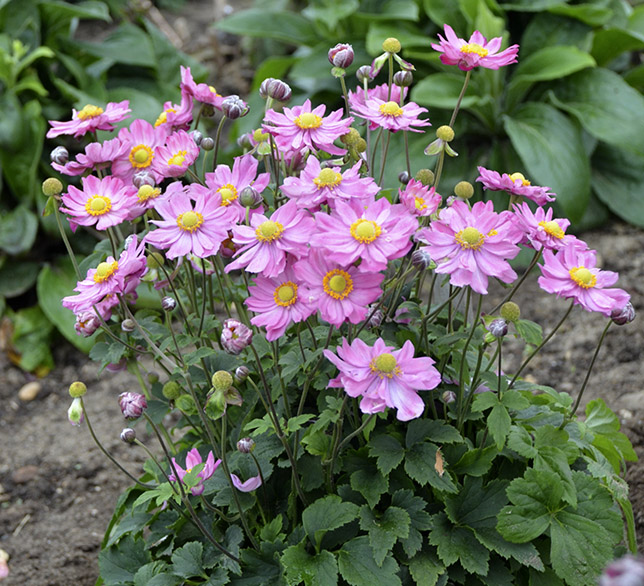Ah, the glory of a massive Joe Pye Weed in full September bloom, or the golden glow of amsonia foliage with the setting sun behind. Two vistas that I’ll never see in my 20 x 20 yard. I envy those with too much space to fill—for me it’s difficult to fit four seasons of interest in a postage stamp sized garden.
The same issue might plague beneficiaries of a larger garden that’s relatively mature but missing some flair in the fall. Like me, they don’t have room for 3 cubic feet of billowy aster or a hip-high wall of sunny goldenrod.
Many of us might also balk at the constant deadheading required to keep summer bloomers going through fall. Even if you don’t mind the work, I swear sometimes it feels like caffeinating a sleepy person at midnight—just let them rest already! And if you have some shade, ach, don’t even get me started!
But there are some judiciously sized and fairly well-mannered perennials that will be happy to join your autumn soiree without bulldozing the other guests or drinking all the cider—or soaking up all the sun. Maybe one or two of these will make a pretty pop in your fall landscape.
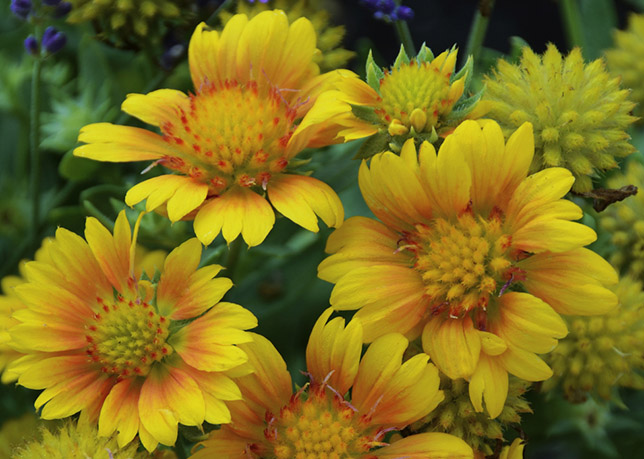
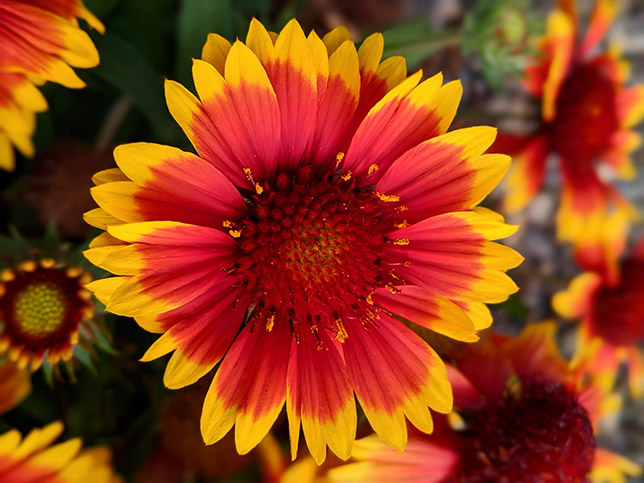
Blanket Flower (Gaillardia): If deadheaded, this heat-tolerant daisy-esque perennial will bloom like an annual all the way until frost. Beware, though, that if it is not well established it may also be non-existent in spring like an annual. Be sure it goes into the winter with a good head of foliage and don’t let it bloom itself to death—you may have to sacrifice some fall flowers to ensure survival.
And I know I said deadheading is a pain, but these are large flowers with stems easily and quickly severed below the foliage, and the seed heads on the ones you don’t cut will be attractive for weeks. Other than that, it is a tidy plant usually no more than 12” x 12” in bloom and asks only for sun and well-drained soil.
If you find the typical searing red and yellow of the species a bit garish, a softer hued variety such as 'Arizona Apricot,' with lemon yellow petals surrounding a light green disk ringed with amber is sure to blend nicely with surrounding plantings. Gaillardias grow in zones 3-10, depending on variety--read plant tags carefully because some are annuals.
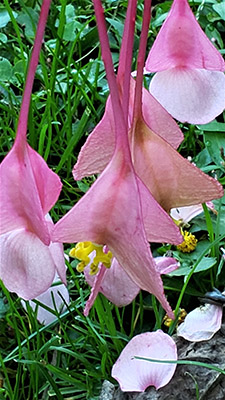
Hardy Begonia (Begonia grandis): Deep pink or white flowers dangle from gently arched stems roughly 18” high. The interesting seed pods are colorful and long-lasting. Shiny spade-shaped leaves of green with red veins on the underside appear late in spring, making a good filler around declining bulb foliage.
It fares best in part to full shade and moist, well-drained soil. In autumn, it will develop bulbils where the leaves meet the stem which will fall and create a thick patch before you know it, or you can harvest and plant where you wish. Lovely skirted with heuchera—pink begonia with purple shades or white begonia with silver or silvery green, and makes a colorful companion to ferns and hostas. Zones 6-7.
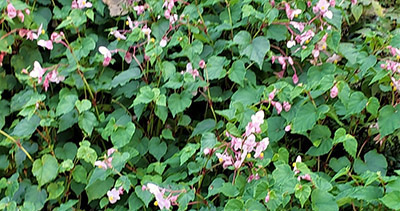
Blue Leadwort (Certostigma plumbaginoides): In northern climes, folks tend to call this “plumbago” because we don’t have real plumbago here. The flowers that begin in June are similar in shape and size, but a bit darker blue, and the plant displays a low spreading habit rather than the somewhat unruly true plumbago.
Autumn turns the foliage to season appropriate shades of red and bronze, making a charming contrast to the remaining fall flowers. A beautiful underplanting for evergreen shrubs or taller perennials and a colorful option for small slopes where evergreen cover is not needed. Full sun to partial shade; no wet spots, please; zones 5-9.
Japanese Anemone, Windflower (Anemone hupehensis and hybrids): There are few garden sights quite so charming as a stand of Japanese anemones in bloom at the edge of a woodland, their precious petalled heads nodding gently on long, wiry stick-figure legs. The airy above the foliage presence allows them to fit in where other tall perennials would overwhelm—foliage usually 12” with flowers up to 3’.
These really come into their own in the fall, unlike other perennials that are just hanging on after their peak summer bloom. If you still need a smaller profile, breeders have more recently supplied plenty of compact cultivars.
Just don’t expect to get the same gracefulness as that of their larger cousins—the shortened stems all but eliminate that lissome quality in favor of a somewhat congested appearance, at least to my eye. But with a lot of color condensed into a smaller package, perhaps they make up in impact what they lack in natural elegance.
For taller plants, tried and true favorites include single white ‘Honorine Jobert,’ and silvery pink ‘September Charm.’ Semi-double flowers are found on white ‘Whirlwind,’ soft pink ‘Queen Charlotte,’ and rosy-pink ‘Serenade’ and ‘Max Vogel’ In a Chicago Botanic Garden trial, both ‘Serenade’ and ‘Max Vogel’ bloomed for over 60 days, with the latter even blooming after the first frost.
If you insist on a smaller plant, try one of these: ‘Wild Swan’ grows 1-2 feet, blooming white with a blue wash on the reverse of the petals—distinctive and attractive, this would be my choice--it better retains the elegant look of the larger varieties. Very long bloom time, even up to frost. The Curtain Call series displays a neat habit up to 18” high and as wide, flowering from late summer to early fall. Large single or semi-double 2” pink or white flowers adorn the Pretty Lady series, growing 12 to 18 inches tall depending on which of the 5 varieties you choose.
Site Japanese anemones in moist, well-drained soil and full to part sun for best performance--morning sun is best in hot climates. Zones 4-7, depending on variety.
Asters: What’s a fall garden without asters? Besides being one of the best sources of late season nectar for pollinators, they’re native, usually deer resistant, and flower prolifically from August or September to October. But choose your aster carefully, unless you have room to enjoy the typical billowing cloud of bloom. Compact cultivars that won’t overwhelm your garden and display mildew resistance are the ones to look for. ‘Purple Dome’ is the classic royal purple aster with a well-behaved habit, growing to 2 feet high and wide, and has ok mildew resistance—just give it good air circulation and don’t let it dry out. ‘Little Carlow’ is a 1.5 x 2’ mildew resistant specimen with bright violet-blue flowers. ‘Blue Bird’ is similar to ‘Little Carlow,’ but grows a foot or so larger. 'Pink Mist' and 'Sapphire Mist' are two nicely compact asters with a height of 12-16 inches and spreading to just 1 foot, in rich, bright pink and deep lavender-blue, respectively. 'Wood's Pink' and 'Wood's Purple' top out at 1.5 feet, 'Wood's Blue' at just 8 to 12 inches.
Asters are tough and adaptable, best in full sun but tolerate part sun and clay soil. To help control the size and improve branching of any aster, cut back to 6” in spring. By the way, Asters are no longer asters anymore. Recent DNA findings have resulted in the new name Symphyotricum. Ah, why is it never just ‘Bob’? Zones 3-8, depending on variety.
Lesser Calamint (Calamintha nepeta): There’s good reason why this was Perennial Plant of the Year for 2021. How could you not love a plant that’s fragrant, drought-tolerant, deer resistant, extremely long-blooming, and attracts hordes of hungry pollinators?
With cultivars that top out at 2’ high and wide, it’s also a polite tenant in the garden. Tiny flowers and minty-scented foliage cover the upright stems until hard frost, ‘White Cloud’ in white at 2’, and ‘Blue Cloud’ in palest blue at 12” high by 12-18” wide. Site in full to part sun and dry to average well-drained soil and just wait for the butterflies. Zones 5-9.
Perennials with showy foliage are an easy way to add color over a long season. These three can fit easily in any garden for an extra pop:
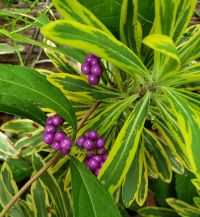
Euphorbia 'Ascot Rainbow': This is one of those plants I must never be without. Gorgeous multi-colored foliage with varying shades and amounts of green, yellow, cream, orange, pink and red (depending on the season) perfectly accents almost any flowers or foliage surrounding it. It rarely needs water, laughs at the heat, and lasts well into the winter in my Zone 7. If I had deer, they would turn their noses up at it.
The tiny spring flowers are surrounded by long-lasting chartreuse cup-shaped, red-centered bracts that perch atop the foliage on wiry stems. They look as if they belong in an alien flower bouquet. But the color is the thing--you can see it from a mile off, yet it doesn't seem to overpower. With a mature size of 1.5 -2' high and wide it makes a big impact without taking up a lot of space. Try it for fall planted with pale yellow, orange, and red pansies--monochromatically spectacular. If contrast is your thing, let it make friends with purple heuchera or a vivid blue aster or violas. You can build a million combinations around this plant--it plays the role of either star or supporting cast just as well. Site it in full sun and give your watering can a rest. Zones (5)6-9.
Heuchera: The ultimate foliage perennial. Well, breeders must believe that because there's literally hundreds of varieties and no seeming end to the new releases. Not that I mind, mind you--my container gardening motto has long been "a heuchera in every container." Pick a color--purple, silver, green, red, orange, chartreuse, peach, bronze, burgundy--they've got that--sometimes one or more in the same plant. Heuchera provide 3, and almost 4, seasons of color, with or without flowers.
Now they're being interbred with tiarella, and we have heucherella, thus expanding the range of flower colors, patterns, and habits. It boggles the mind, but in the end it means there's certainly a heuchera or heucherella that will beautifully accent almost any garden spot you have! Most are best grown in partial shade, with varying degrees of sun tolerance between varieties. All require a very well-drained soil to prevent crown rot. Wonderful in containers, alone or with friends. Zones 4-9.

Carex: Most varieties are relatively small, narrow-leaved with a fine texture, and many are evergreen. They grow slowly, and as a cool-season grass they aren't going to push much in summer. This makes them perfect for that small spot in your garden or container that needs a little oomph--either color or texture, or both. Some of the best are members of the EverColor series--averaging 1' high and wide with varying patterns and degrees of linear variegation in white, gold, or yellow. 'EverOro' is a solid choice with a wide bright gold center stripe edged in dark green. Zones 5-9.
*Remember that the plants we recommend may not be suitable in all areas--please check with your local Cooperative Extension or state/county agricultural agency for information on invasive species in your location.*


